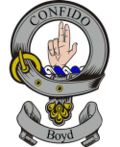- Profile
- Images
Location: [unknown]
Surnames/tags: Scottish_Clans Boyd
Scotland Project > Scottish Clans > Clan Boyd
Contents |
Welcome to Clan Boyd
| Clan Boyd Team | ||
|---|---|---|
| Team Leader | TBA | |
| Team Members | Beth Golden, Dennis Orr | |
- Clan Chief: Robin Jordan Boyd, 8th Baron Kilmarnock, Chief of Clan Boyd, succeeded his brother the 7th Baron in 2009.
- Crest: A dexter hand erect and pale having the outer fingers bowed inwards
- Motto: CONFIDO (I trust)
- Slogan/War Cry:
- Region: Lowlands
- Historic Seat: Dean Castle, Ayrshire, with traditional lands in Bute
- Plant badge: Laurel leaves
- Pipe music:
- Gaelic name:
Clan Team
Team Goals
The focus of this team's work is to identify, improve and maintain profiles associated with the Lairds and Chiefs of Clan Boyd together with members bearing the name Boyd, the related families and those recognised as septs of Clan Boyd.
Team To Do List
This list will be developed by the Team. If you are working on a specific task, please list it here:
- promoting the entries of those bearing the name Boyd on Wikitree.
- ensuring entries appearing on Wikitree are as accurate as possible, correcting mistakes once spotted.
- encouraging interest in and study of Clan Boyd.
Septs
Clan History
Please develop a brief summary.
Clan Branches
Boyd of Merton
Boyd of Penkill
Boyd of Pitcon
Boyd of Trochrig
Other Names Associated with the Clan
Blair, Bowie, Boyd, Brown, Burns, Campbell, Crawford, Cunningham, Fairlie, Fullerton, Muir, Ross, Stewart, Stuart, Moore, George, Osborne, Air, Ayr, Ayre, Ayrd, Assloss, Auchinleek, Auchinloss, Bankhead, Boid, Boit, Boite, Borland, Boyde, Boyte, Boydston, Boyman, Braland, Bribane Bute, Cassy, Cherry, Cherrie, Chystal, Conn, Coon, Coonie, Corsehill, Cosh, Crystal, Cunninghame, Dick, Fairly, Faerie, Faery, Fairie, Fairy, Farie, Faul, Faulds, Fauls, Fenwick, Fulton, Fullarton, Foulterton, Gammell, Gemmell, Good, Gorman, Gurman, Haire, Hair, Hare, Harshaw, Line, Lines, Linn, Lynn, Lind, Longmoore, Longmuir, MacBoyd, MacAboy, MacBee, MacCosh, MacLorg, MacLurg, Osborn, Parris, Pitcon, Raeburn, Rayburn, Reburn, Rigg, Riggs, Speirs, Spiers, Spires, Steuart, Stiret, Starret, Steen, Stein, Tannahill, Tannock, Templeton, Underwood, Vasser, Vassar, Woodbourne, Woodburn
Allied Clans
Clan Research and Free Space Pages
| Clan Name | Crest Badge | Alastair Boyd
7th Baron Kilmarnock | Lands | Tartan
Dress Ancient | Tartan Hunting
Ancient |
|---|---|---|---|---|---|
| CLAN BOYD | 
| 
| 
| 
| 
|
Dean Castle, ancient stronghold of House of Boyd
Origins of the clan
The name Boyd is said to be descriptive, being derived from the Scottish Gaelic buidh which means fair or yellow.The progenitor is said to have been Robert, who was the nephew of Walter fitz Alan, the first High Steward of Scotland. This theory however is challenged by genealogist, Anderson, who points out that most of the friends and dependents of the High Stewards were of Norman origin and it is therefore unlikely that they would use a Celtic nickname for one of their own family. Anderson believed the name to be of either Norman or Saxon origin. The historian, Black, asserts that the first Boyds were vassals of a Norman family, the de Morvilles, for their lands around Largs and Irvine.
In around 1205 Robert de Boyd witnessed a contract between the Lord of Eglinton and the burgh of Irvine. Robert de Boyte is listed on the Ragman Rolls, giving homage to Edward I of England in 1296. Wars of Scottish Independence
In 1306 Duncan Boyd was executed for supporting the cause of Scottish Independence.Also during the Wars of Scottish Independence, Sir Robert Boyd was a strong supporter of king Robert the Bruce and was even one of the commanders at the Battle of Bannockburn in 1314. He was rewarded for his gallantry, with lands that had been confiscated off the Balliols, including Kilmarnock, Bodington and other substantial lands n Ayrshire. 15th century
The chief of the clan was raised in the peearge under the title Lord Boyd of Kilmarnock by James II of Scotland. On the death of that king, Robert Boyd, 1st Lord Boyd was appointed as one of the regents to the young James III of Scotland. Boyd's younger brother was appointed as the military tutor to the new king.Lord Boyd was also later appointed as Great Chamberlain while his son, Thoms, was married to Princess Mary, the king's sister and was given the title Earl of Arran. The family's success naturally brought them powerful enemies and those opposed to the Boyds began conspiring against them. In 1469 Lord Boyd along with his son, Thomas, and his brother, Alexander were summoned to appear before the king and Parliament to answer charges made against them. Lord Boyd realizing that he faced death escaped to England, while his brother Alexander was executed. His son, Thomas, the Earl of Arran, had been on state business abroad and upon learning of the reversal of his family's fortunes accepted his exile but was well received in royal courts throughout Europe. 16th century
The Boyd family were restored to royal favour when Robert Boyd, a descendant of the first Lord Boyd received confirmation of all the family's estates and honors from Mary, Queen of Scots.After the Queen's escape from Lochleven Castle, Lord Boyd was one of the first to join her and fought for her at the Battle of Langside. He later made many visits to her when she was held captive in England. He died in 1590.
17th century and Civil War
During the Wars of the Three Kingdoms the Clan Boyd supported the royalist cause. They were rewarded after the Restoration (1660) when William, Lord Boyd was created Earl of Kilmarnock. 18th century and Jacobite risings
The third Lord Boyd opposed the Jacobite rising of 1715 and commanded a regiment of Ayrshire volunteers for the government. However his son, the fourth Lord Boyd, did support the Jacobite rising of 1745 and fought for Charles Edward Stuart at the Battle of Culloden in 1746, after he had made him a member of the Privy Council with the rank of general. Boyd was captured at the Battle of Culloden and taken to the Tower of London. He was beheaded on Tower Hill on 18 August 1746. All of the Boyd titles were then forfeited, however his eldest son succeeded through his mother to the title of Earl of Erroll and changed his surname to Hay.
Modern history
The 22nd Earl of Errol died in Kenya in 1941. His daughter was entitled to succeed in the earldom of Erroll and the chiefship of the Clan Hay but was excluded from the barony of Kilmarnock which could only pass to males. Consequently the brother of the 22nd Earl resumed the surname of Boyd and succeeded to the barony of Kilmarnock.
Source Material
===Image Credits and Acknowledgements===
- Login to request to the join the Trusted List so that you can edit and add images.
- Private Messages: Send a private message to the Profile Manager. (Best when privacy is an issue.)
- Public Comments: Login to post. (Best for messages specifically directed to those editing this profile. Limit 20 per day.)
- Public Q&A: These will appear above and in the Genealogist-to-Genealogist (G2G) Forum. (Best for anything directed to the wider genealogy community.)


